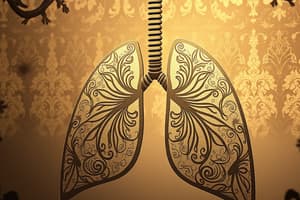Podcast
Questions and Answers
What happens to the pressure in the pleural space (Ppl) during the inspiration phase?
What happens to the pressure in the pleural space (Ppl) during the inspiration phase?
- It increases.
- It remains constant.
- It fluctuates unpredictably.
- It decreases. (correct)
According to Poiseuille's Law, what effect does a decrease in tube radius have on gas flow if pressure remains constant?
According to Poiseuille's Law, what effect does a decrease in tube radius have on gas flow if pressure remains constant?
- Gas flow stays the same.
- Gas flow increases exponentially.
- Gas flow decreases to one-sixteenth of its initial value. (correct)
- Gas flow doubles.
What is the main factor that causes airway resistance (Raw)?
What is the main factor that causes airway resistance (Raw)?
- The temperature of the gas.
- Pressure differences between the mouth and alveoli. (correct)
- The viscosity of the gas only.
- The length of the airway only.
Which of the following statements correctly describes laminar flow?
Which of the following statements correctly describes laminar flow?
How is dynamic compliance (CL(dyn)) defined?
How is dynamic compliance (CL(dyn)) defined?
What does a high time constant (TC) indicate about a lung region?
What does a high time constant (TC) indicate about a lung region?
What does Poiseuille's Law suggest about the relationship between pressure, flow, and tube radius?
What does Poiseuille's Law suggest about the relationship between pressure, flow, and tube radius?
When is turbulent flow typically observed?
When is turbulent flow typically observed?
What happens to the bronchial airways during exhalation?
What happens to the bronchial airways during exhalation?
What is the normal range of airway resistance (Raw)?
What is the normal range of airway resistance (Raw)?
Flashcards are hidden until you start studying
Study Notes
Dynamic Lung Mechanics
- Involves the study of forces affecting gas movement in and out of the lungs.
- Pressure changes (P changes) are essential for gas flow.
- Governed by Poiseuille's Law and airway resistance equations.
Poiseuille’s Law
- During inspiration, pleural pressure (Ppl) decreases, leading to bronchial airway lengthening and passive dilation.
- During exhalation, the opposite occurs; bronchial airways shorten and decrease in diameter.
- Abnormal conditions can alter bronchial gas flow and pleural pressure, impacting overall gas exchange.
Poiseuille’s Law for Flow
- Flow (°V) is calculated using the formula °V = ΔPr^4 π / 8lη.
- Factors influencing flow include:
- Increase in pressure (ΔP) and radius (r) enhances flow.
- Increase in viscosity (η) and length (l) reduces flow.
- Reducing tube radius by half results in a flow decrease to one-sixteenth of the initial flow.
Poiseuille’s Law for Pressure
- Pressure (P) relation to flow: P = °V 8lη / r^4 π.
- Pressure is directly proportional to flow, length, and viscosity.
- Increased tube radius results in decreased pressure.
- Final combined equation: P = °V / r^4 thus °V = Pr^4.
Airway Resistance (Raw)
- Airway resistance (Raw) is the pressure difference between the mouth and alveoli (Pta).
- Normal airway resistance ranges from 1.0 to 2.0 cm H2O/L/sec.
- Two flow types exist:
- Laminar Flow: Streamlined, low flow rates, low pressure gradients.
- Turbulent Flow: Random gas movement at high flow rates, high pressure gradients.
Time Constants
- Defined as the product of Raw and lung compliance (CL).
- Represents the time needed to inflate a lung region to 60% of its filling capacity.
- Regions with high Raw and high CL require more time (Long Time Constant) for inflation.
- Formula: TC(sec) = (πP/°V) Raw x (πV/πP) CL.
Dynamic Compliance
- Refers to how easily a lung area fills during gas flow.
- It is influenced by the time constants of the lung regions.
- Dynamic compliance (CL(dyn)) is assessed during periods of gas flow.
Studying That Suits You
Use AI to generate personalized quizzes and flashcards to suit your learning preferences.




